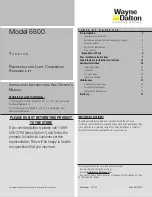
Roller
spacer
Counterbalance
cable loop
1/4”-20 x 11/16”
Self drilling screws
Short stem
track roller
Milford pin
Bottom
corner
bracket
End cap
End cap
Bottom
corner
bracket
Counterbalance
lift cable
Bottom
weather
seal
Bottom
section
Bottom
section
Bottom
weather
seal
Counterbalance
lift cable
Counterbalance
cable loop
Milford pin
Roller
spacer
Short stem
track roller
(3) 1/4”-20 x 11/16”
Self drilling screws
(RED HEAD )
(3) 1/4”-20 x 11/16” Self
drilling screws (RED HEAD )
Roller
spacer
Counterbalance
cable loop
1/4”-20 x 11/16”
Self drilling screws
Short stem
track roller
Milford pin
Bottom corner
bracket
End cap
Counterbalance
lift cable
Bottom
weather
seal
Bottom
section
(3) 1/4”-20 x 11/16” Self
drilling screws (RED HEAD )
1/4”-20 x 11/16”
Self drilling screws
End cap
Bottom corner
bracket
Bottom
section
Bottom
weather
seal
Counterbalance lift cable
Short stem
track roller
Counterbalance lift cable loop
Cotter pin (attached into
place from opposite side
of bottom corner bracket)
Clevis pin (inserted through cotter pin
and bent into place)
Washer
(3) 1/4”-20 x 11/16” Self
drilling screws (RED HEAD )
1/4”-20 x 11/16”
Self drilling screws
Bottom
corner
bracket
End cap
End cap
Bottom
corner
bracket
Bottom
weather
seal
Bottom
section
Bottom
section
Bottom
weather
seal
(3) 1/4”-20 x 11/16” Self
drilling screws (RED HEAD )
(3) 1/4”-20 x 11/16” Self
drilling screws (RED HEAD )
Attaching Track Roller Carriers
5
NOTE:
If you don’t have track roller carriers, then skip this step. Refer to Package Contents /
Breakdown of Parts, to determine if a track roller carrier was supplied with your door.
Starting on left hand side of the bottom section, attach the track roller carrier with the stamp
“STD” facing UP to the bottom corner bracket by aligning the four holes of the track roller
carrier with the four holes in the bottom corner bracket. Secure the track roller carrier to the
bottom corner bracket using 1/4” - 20 x 7/8” self drilling screws, as shown. Repeat for the
other track roller carrier and repeat the same process for the right hand side.
NOTE:
The track roller carrier’s inner holes are used on doors with 2” track applications with
a short stem track roller; the outer holes are used on doors with 3” track applications with a
long stem track roller.
Bottom corner
bracket
Bottom
section
Short stem
track roller
(4) 1/4” - 20 x 7/8”
Self drilling screws
Track roller
carrier
“STD”
facing UP
Roller spacer
Side view of track roller
carrier(s)
Inner holes
(2” Track)
Outer holes
(3” Track)
Bottom corner
bracket
Bottom
section
Long stem
track roller
(8) 1/4” - 20 x 7/8”
Self drilling screws
Track roller
carrier
“STD”
facing UP
Roller spacer
Side view of track roller
carrier(s)
Inner holes
(2” Track)
Outer holes
(3” Track)
Track roller
carrier
Attaching Hinges To Sections
6
NOTE:
Refer to door section identification, located in the pre-installation section of this
manual to determine what size sections you need to use as your lock (second) section, inter-
mediate (third) section, intermediate (fourth) section, intermediate (fifth) section, intermediate
(sixth) section and top section. Measure your sections to make sure they are the correct
height as indicated on the chart.
NOTE:
The graduated end hinges can be identified by the number stamped on the lower
hinge leaf. The #1 graduated end hinges serves as end hinges on the bottom section. The #1
graduated end hinges also serves as center hinges on all sections, except for the top section.
NOTE:
The #2 graduated end hinges serves as end hinges on the Lock section.
NOTE:
The #3 graduated end hinges serves as end hinges on the Intermediate I section.
NOTE:
The #4 graduated end hinges serves as end hinges on the Intermediate II section.
NOTE:
The #5 graduated end hinges serves as end hinges on the Intermediate III section.
NOTE:
The #6 graduated end hinges serves as end hinges on the Intermediate IV section.
NOTE:
Depending on your door, single end hinges and short shaft rollers MAY be required on
each end of the bottom, lock and intermediate(s) sections.
NOTE:
Depending on your door, double end hinges and long shaft rollers MAY be required on
each end of the bottom, lock and intermediate(s) sections.
Using sawhorses, lay the section on a flat smooth surface. Starting on the left hand side of
the section, align the lower leafs of the appropriate graduated end hinges over the holes at
the top of the end caps located at the top of the section. Next, align the lower hinge leafs of
the #1 center hinges with the dimples at the center location(s) located at the top of the sec-
tion. Secure the graduated end and center hinges to the section using (2) 1/4” - 20 x 11/16”
self drilling screws.
IF YOU HAVE DOUBLE GRADUATED END HINGES:
Position and align the lower leaf of the
appropriate graduated end hinges over the inner holes at the top of the end caps located at
the top of the section. Attach the graduated end hinges to the section using (2) 1/4” - 20 x
11/16” self drilling screws.
Insert a short / long stem track roller into each graduated end hinges. Repeat graduated
hinge and center hinge attachment using the appropriate graduated end hinges for all
remaining sections except the top section.
8























